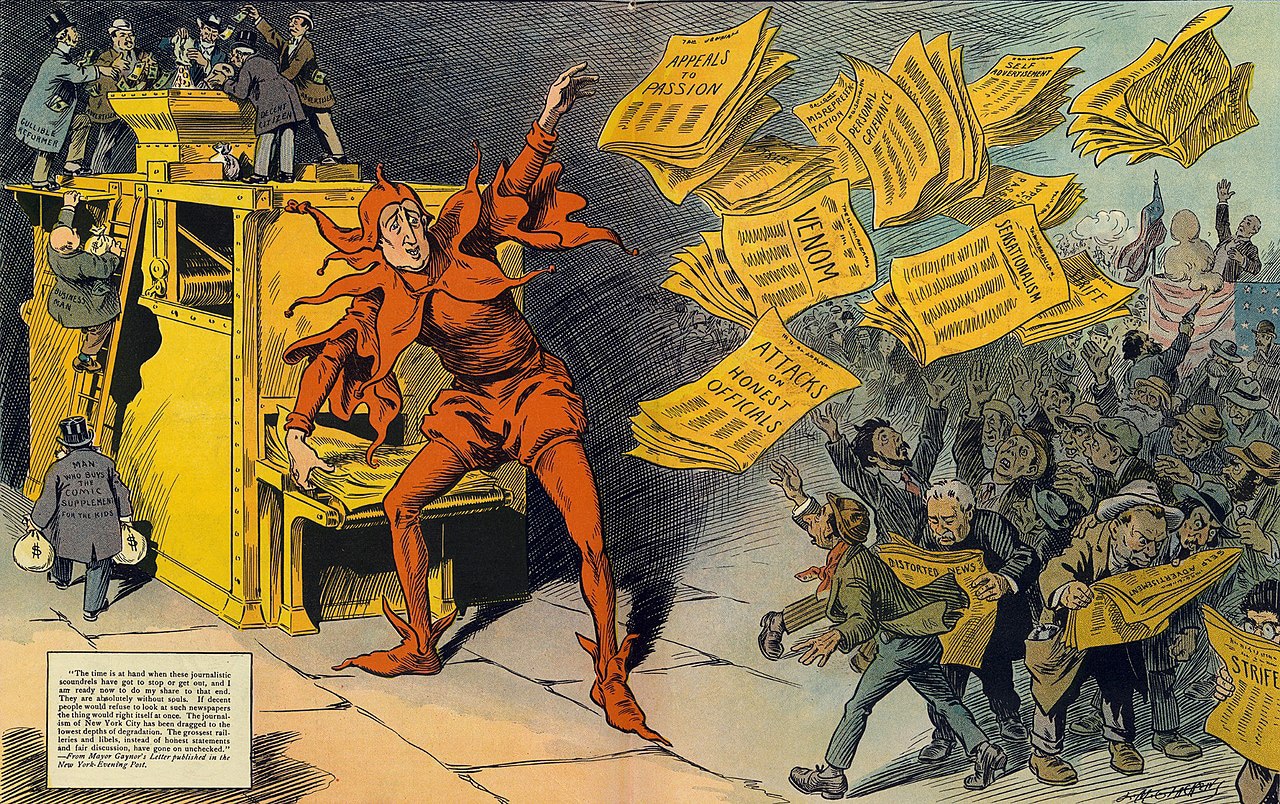
Uh, Oh: New York Times, Washington Post Signal Post-Election Crackdown
by Matt Taibbi | Oct 25, 2024
In Wednesday’s Washington Post, author Matt Bai (definitely not a relation) worried about “Our Deepening Cold War.” While there might be an unspecified “Resistance” reaction from Democrats if Kamala Harris fails, extreme means might be necessary to protect the public if Donald Trump “narrowly loses”:
Republicans in Congress seem cowed enough not only to halt the counting of votes, but also to reject electoral college certification altogether. Restoring order might fall not just to the courts, but to the military as well.
Bai describes the dilemma of the rectitude-filled, democracy-defending Post reader, for whom losing this election would mean opting “out of the shared American project altogether” to “wait for redemption.” But can one afford to wait? Trump, called a fascist in “truly astounding” quotes by former generals, is of course a threat, but is he survivable? In other words: “Can the country bend without breaking?”
It’s always interesting when the same phrases pop up at the same time in similar editorials. The “bend” question appeared a day later in a New York Times editorial, “There Are Four Anti-Trump Pathways We Failed to Take. There Is a Fifth.” Harvard professors Steven Levitsky and Daniel Ziblatt answered Bai’s question in the negative. Trump, they say, has promised to prosecute political rivals, “deploy the army to suppress protest,” and deport as many as 20 million people. Through such comments, “Mr. Trump is forthrightly telling Americans that if he wins, he plans to bend, if not break, our democracy.”
But we can’t afford to take that risk, suggest Levitsky and Ziblatt, whose screed is furious, pessimistic, and paranoid. It walks readers through four failed options for stopping a “clear threat to American democracy” in Trump, then proposes a more extreme fifth.
What about just letting voters choose? No go, explain the Harvard men:
Electoral competition is, of course, essential to democracy. But…
Voting turns out to be the first of the professors’ four failed ways in which “democracies protect themselves”:
The traditional American response to extremism… We rely on the self-correcting power of electoral competition… But a laissez-faire approach has two important limitations. First, in the United States, competition is distorted by an 18th-century institution, the Electoral College… [and] history shows us that electoral competition alone is insufficient to fend off extremist threats… Candidates seeking to subvert democracy don’t always lose.
Trump could still win elections, so they’re out. Having dismissed the bend, the academics plan to stop the break, cycling through hardcore options. Trump-stopping method two is lawfare, which they call “militant or defensive democracy,” wherein authorities “wield the rule of law against antidemocratic forces.”
But courts refused to strike Trump from the ballot, so that’s a sad-trombone dead end. The third defense, “Partisan gatekeeping,” is tossed because useless Republicans refused to bar Trump from use of party infrastructure. Method four, building a “mutliparty coalition” (what the French call a cordon sanitaire) is bust because Republicans like Nikki Haley still support Trump, and the ones who don’t, like Mitt Romney, Mike Pence, and George W. Bush, lack the decency to support Harris. “As long as Republican leaders who privately view Mr. Trump as a grave danger refuse to go public,” they write, “most Republican voters will remain unmoved.”
It never occurs to Levitsky and Ziblatt that Republican voters have minds of their own, that “partisan gatekeeping” is among the main things they’re voting against, or that there are species of flatworms and mold with more voter pull than Pence or Romney.
No matter. They move to Choice Five (a future dystopian novel title?). This is “societal mobilization,” really a color revolution minus the term. They describe an uprising of business, religious, and civic groups serving as the firewall that can “forcefully repudiate” the threat. Their lead example is the German rejection of the rightist AfD, in which Mercedes-Benz, Porsche, and “top unions” joined “millions of citizens from across the political spectrum” who “gathered week after week in large cities and small towns in defense of democracy.” It’s a happy story, but the essay ends in a cascade of frustration at U.S. business leaders who insist they can “survive and thrive” under either party, as Chase’s Jamie Dimon did.
“The U.S. establishment is sleepwalking toward a crisis,” the professors complain. “What are they waiting for?”
Elections, you think? But no, the premise of these pieces is that the people Levitsky and Zilbatt call “prodemocratic forces” can’t risk waiting for Trump to do the bad thing that necessitates an overthrow. Democracy, they say, is a “paradox.” It’s premised on a system of open competition, but “what if a major candidate seeks to dismantle that very system?” Shaking that Magic 8 ball a few times, they arrive at their PREEMPTIVE ACTION NECESSARY thesis.
These ideas have been in the ether, but are ramping up in conjunction with an avalanche of warnings about a coming insectoid rebellion in the face of expected electoral delays. Chuck Schumer and five other Senate Democrats went so far as to issue a report chiding constituents that “vote totals on election night might not give us a complete picture of who will win,” but we’re not to worry, because “voter fraud is nearly nonexistent.” CNN has been running a loop of increasingly bizarre stories about officials building drone-patrolled, cement-reinforced “fortresses” to fight off the hordes of misinformation-addled populists expected to “rush” ballot centers when results don’t come in.
These warnings fall under the category of “pre-bunking,” a practice in which authorities try to inoculate against badthink by seeding the public with possible bad news in advance of an election, a storm response, a new vaccine policy, etc. Pre-bunking is the messaging equivalent of a doctor warning of a “little pinch” before shoving a forearm up the clacker. Homeland Security officials have a near-religious belief in “building resilience” through such tactics. Still, you could appoint a chimpanzee to run DHS and it should know that if you warn people not to worry about something ten billion times, they will start to do just that, especially when the not-worrisome thing is a nuclear superpower’s sudden inability to count. So what gives? For what bad news are we really being prepared?
The DHS says pre-bunking is most effective when officials establish “working relationships with media” ahead of events like elections. Unfortunately, these Fed-media partnerships often result in “People of Earth!”-style dictates, delivered via softball interviews of enforcement creeps that, again, almost certainly increase fears of corruption. Take a CBS story from October 4th on an intel bulletin “obtained” (lol, no one was hiding this document) from the FBI and DHS. It reveals that “extremists” wigging out about “perceived election fraud” might soon attack “election-related targets.” This comes out in an interview with “national security contributor” Samantha Vinograd, who looks like a Westworld escapee and is somehow never identified as a longtime senior DHS official as she extols a DHS report’s themes. “This violence could persist at least through January 20th, 2025,” she says. Does this cyborgian segment make you worry more or less about manipulation?
Reports of official “anxiety” about potential “chaos and unrest” have been coming in huge quantities. If you now add mention of “social mobilization” or restoring order with “the military” to that mountain of agita, it suggests a certain scenario has been coming up too often in someone’s tabletop dice rolls. Post-election delays followed either by a jarring result or more uncertainty triggers “clashes” or “violence,” which then impels “prodemocratic forces” to take emergency action. To say officials are on high alert for signs of such “unrest” would be a massive understatement. A Wednesday Times story about potential trouble spots sourced to “democracy watchdogs” suggests anything not dressed in J. Crew or carrying a laptop could be a threat. On Esmerelda County, Nevada:
This southwestern Nevada county, with its mining history, ghost towns and fealty to the former president, has become illustrative of the hostility toward election officials.
If places with a “mining history” are suspect, counties with trailers, rodeo, and pig lagoons can’t be far behind. It might be a good idea to put mesh hats away for a few weeks. Good God.
Trump had obviously helped raise tensions. He promised to jail anyone guilty of “cheating and skullduggery,” warned of “bedlam,” and among many other things, said “our elections are bad” because “a lot of these illegal immigrants coming in, they’re trying to get them to vote.” If he loses, there will of course be anger toward what the DHS calls “perceived political adversaries,” and claims of fraud are likely.
But he’s out of power, and any trouble he could cause is a for-later problem compared to the ”paradox” his opponents have talked themselves into. The Democrats’ entire argument now is a vote for Trump is a vote for historical infamy, and he must not only be beaten, but eliminated as an option. “We gotta lock him up… politically,” is how Joe Biden put it. The Harris campaign by week’s end degenerated into surrogates shouting “Hitler!” into the void, with everyone from Kamala herself to Walz to Hillary Clinton pounding the “fascist to the core” theme. An openly frustrated former CIA chief John Brennan denounced as “appalling” the fact “so many Americans” are tuning them out when they drop the H-word:
They don’t sound like people sure about the wisdom of conceding. What if that’s the bad news all this pre-bunking is preparing us for?






